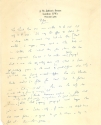On April 11, 2017, on the occasion of the screening of the 2016 film Silence, based on Shūsaku Endō's novel of the same name, and a conversation with its director Martin Scorsese, staff of the Booth Family Center for Special Collections exhibited a selection of items relating to Endō and Graham Greene. Both Endō and Scorsese have cited Greene as a significant influence. The items presented here from Georgetown's rich holdings of Catholic literary figures testify to the inter-relatedness of the work of all three.
Shūsaku Endō
Photograph, signed by Endō in both Roman and Japanese script.
Silence
Shūsaku Endō (1923-1996)
Translated by William Johnston
Tokyo: Sophia University, 1969
Graham Greene, one of Endo’s greatest supporters in the West, inscribed this copy of the English translation of Silence to Fr. Leopoldo Durán: “My pen-friend Endo would love to know that he was read by my travel companion in Spain.” Greene’s close friend Durán served as the model for and dedicatee of Greene’s Monsignor Quixote.
Shūsaku Endō Letter
Shūsaku Endō, 1923-1996
Typed letter signed, 12 April 1991
Clearly eager for his novels to be adapted to the big screen, Endō writes his publisher, Peter Owen, “Thank you very much for the good news that Mr. Scorsese has finally signed the contract....” In a later letter, Endō informs Owen that he has watched several of Scorsese’s films.
Shusaku Endo–Peter Owen Collection, second accession, box 1, folder 2
"The Third Man" Manuscript
Graham Greene (1904-1991)
The Third Man
Autograph manuscript
Preface, page 1 and Chapter 1, page 1
Greene confesses the extent of his cinematic imagination in the preface to his novella: “The Third Man was never written to be read but only to be seen.” Writing in The Independent in 2015, Martin Scorsese remarks that Carol Reed’s film of The Third Man (1949) features “the best revelation–or the best reveal, as they say–in all of cinema,” in the scene in which Orson Welles first appears as Harry Lime.
"Tōbōsha" ("The Power and the Glory")
Graham Greene (1904-1991)
Tōbōsha [The Power and the Glory]
Tokyo, 1951
Greene imitates Japanese script in his inscription to Catherine Walston: “To Catherine with so much love from Graham before I hope Switzerland.” Some critics have suggested that Silence is Endō's answer to The Power and the Glory, and Martin Scorsese reports that he re-read Greene's novel while shooting his film version of Silence.
Honorary Doctorate Citation for Shūsaku Endō
Georgetown University Commencement program, 1987
Citation awarding an honorary doctorate to Shūsaku Endō
The citation observes that “In his novel, Silence, [Endō] raises an unbearable question: should a missionary apostatize if it will save poor peasant converts from torture and death? If he did so, would he be acting like Judas? Or like Christ?”
From the Georgetown University Archives
Exhibition curated by Dr. John Buchtel, Director-Booth Family Center for Special Collections











